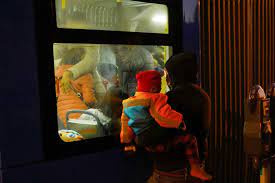Yi Xin
In the grand theater of the United States’ foreign policy, where insincerity takes center stage and contradictions perform a ballet of confusion, the US immigration policy stands out as a masterpiece of paradox. A jumble of inconsistency and mixed signals, their immigration policy is a tour de force that leaves observers scratching their heads and would-be immigrants caught in a bewildering dance.
The US prides itself on being a nation of immigrants. Self-styled as “a beacon of opportunity and hope”, the nation has a long history of letting in people from Latin American countries, with Mexicans representing the largest group of immigrants for decades. A former US president observed: “The basic idea of welcoming immigrants to our shores is central to our way of life – it is in our DNA.”
Yet his successor paved the path to the presidency with the promise of a “big, beautiful wall” along the US border with Mexico. During Iowa’s Republican caucuses late last month, immigration remained a top issue. A survey found about 9 in 10 caucus-goers backed building a wall, with about 7 in 10 expressing strong support for the idea.
This would raise the eyebrows of even an imaginative playwright. The US seems to be unfurling a welcome mat and erecting a border wall at the same time. Picture this: sending a grand invitation that beckons those yearning to “breathe free”, while building towering walls that shout “Sorry, not everyone is welcome!” Immigrants are invited to a masquerade ball where they are welcome to dance as long as they don’t mind a few hurdles, such as traversing a fortress-like structure that stretches across thousands of miles.
As the curtains rise on Act II, we find ourselves in the surreal landscape of immigration detention centers. According to the US Department of Homeland Security, in fiscal year 2023, more than 131,000 non-citizen detainees were housed at 19 “designated facilities” throughout the nation, where the US presents a circus of open-air facilities that resemble summer camps. Undocumented families are treated to a spectacle of barbed wire, chain-link fences and the dulcet tones of immigration officers singing “Welcome to the Land of the Free.”
The US brilliantly manages to turn detention into a scenic retreat, complete with caged enclosures for the little ones. It’s a circus where the acrobatics of legal processes defy gravity, leaving detainees in the midst of extreme uncertainty. Recently, those detained in a for-profit detention center in Washington filed hundreds of complaints, yet inspectors have repeatedly been denied entry into it. The US seems to be proclaiming itself as an upholder of human rights while juggling the delicate balance between concerns of all sorts and humanitarian principles.
This act features the guest (or temporary) worker program, a comedic routine where foreign labor is invited to dance a temporary jig on the US stage. The US opens its doors to foreign workers with a wink and a nod, only to ask them to leave when the next round of workers is readily available.
This is a fast-food approach to immigration – order some cheap labor, no questions asked. In most cases, workers will never get the chance to become green card-holders or naturalized citizens. Forget about the tired cliché of the American Dream, just enjoy an American Nap: fill those low-wage jobs with your warm bodies, work hard, pay taxes and then, poof, back to your home country. A classic hodgepodge of contradictions – inviting people to contribute to the economy while making sure they never get too cozy in the American living room.
In addition, there is no shortage of examples of exploitation and abuse under the program. This is because visas bind guest workers to a sole “employer-sponsor” with no flexibility to switch jobs. As such, the worker’s ability to acquire and maintain legal status in the US is entirely contingent upon maintaining a “positive” relationship with their employer. This system enables employers to view workers as commodities that can be conveniently discarded if they fail to comply with demands or for any arbitrary reason whatsoever.
In the grand finale, the audience is left waiting for the punch line that never lands. The irony is thick, the contradictions abundant and the spectacle perplexing. As we exit the theater of immigration absurdity, one cannot help but wonder if the US immigration policy is a tragicomedy intended to amuse, sadden and baffle. Perhaps, in the next act, the US could opt for a more coherent script that aligns with its status as a “beacon”, i.e. adopt a policy that reflects the complexity of migration while respecting the dignity of those yearning for a better life. Until then, this masterpiece of paradox will continue its enigmatic performance, leaving the rest of the world in a state of bewilderment.







